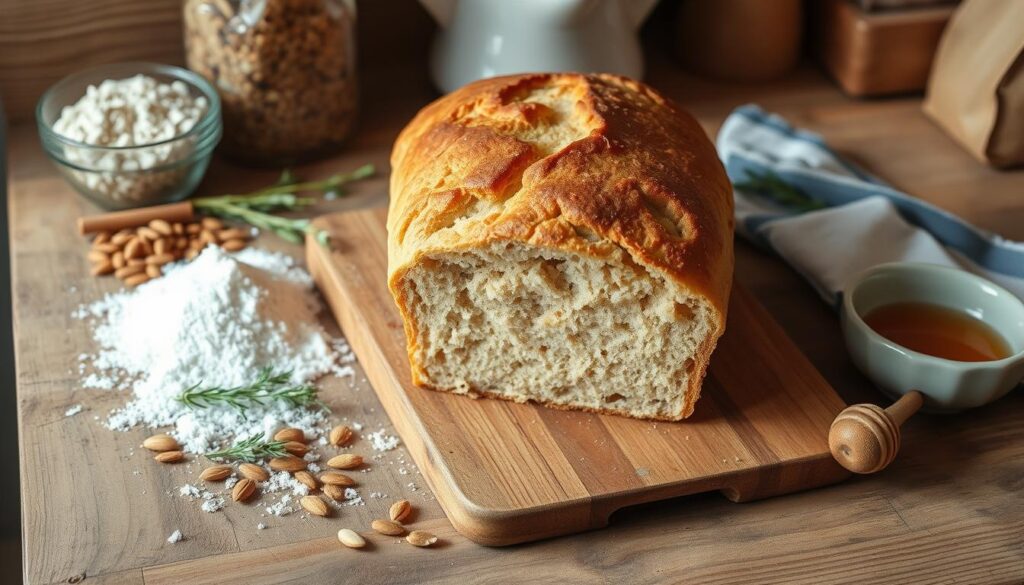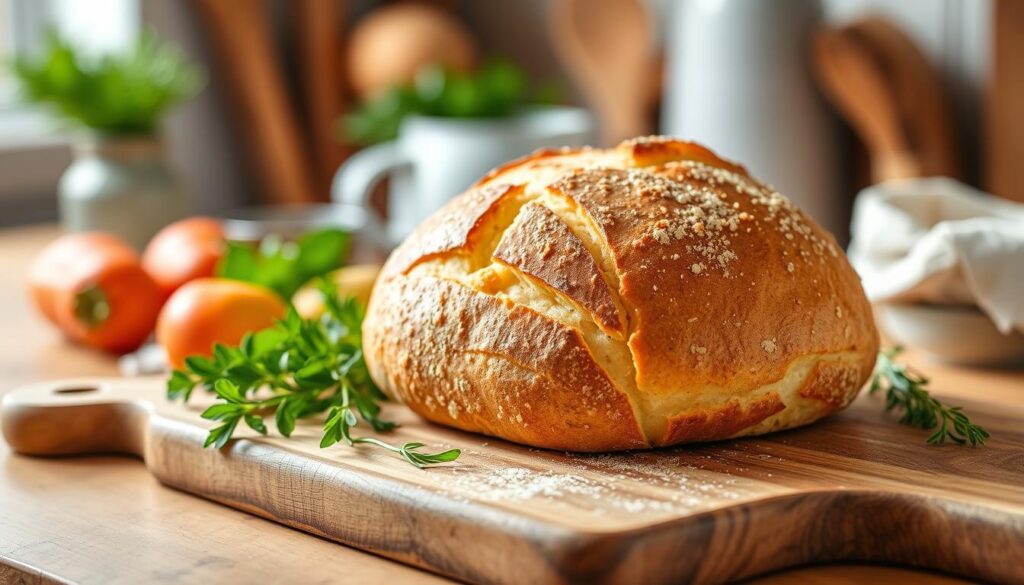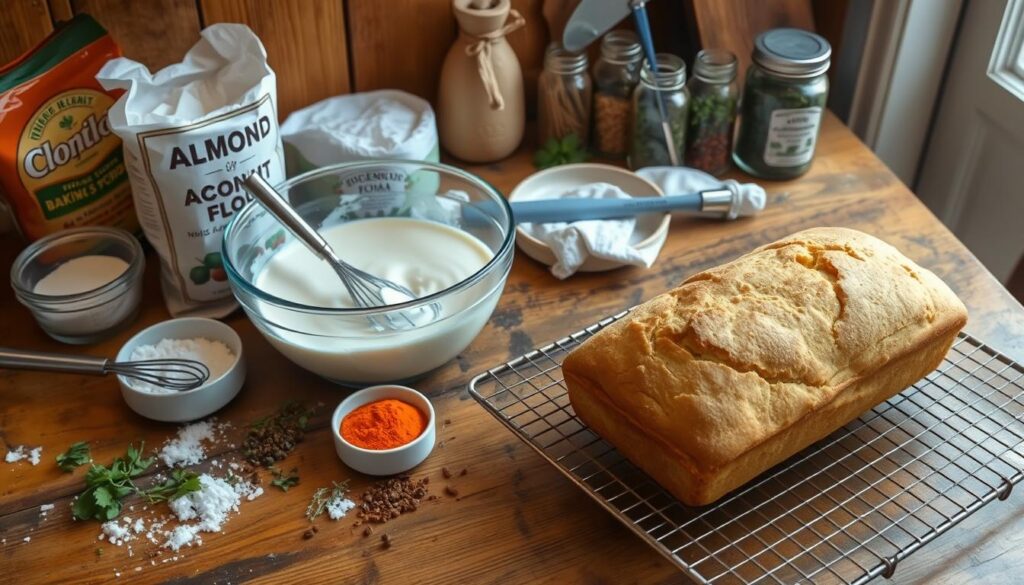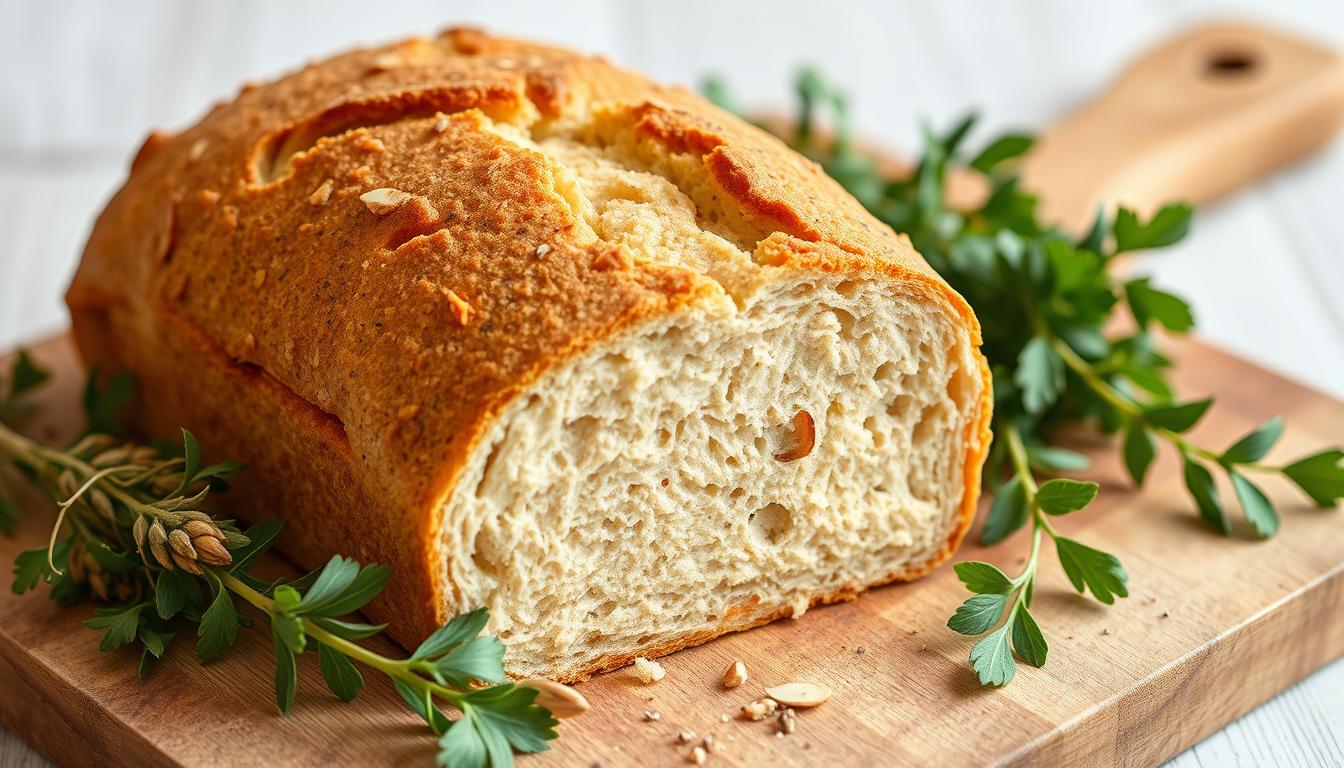Ever felt overwhelmed in your kitchen, surrounded by the smells of baking bread? But then, you remember the dietary rules that seem to block your cooking joy. If you’re on the GAPS Diet, especially at Stage 4, finding tasty, healthy meals can be tough. Especially when eggs are out of the question.
But what if you could make a warm, comforting loaf of bread without eggs? A bread that fits your diet and is full of flavor and texture? That’s what we’re making today. We’ll mix coconut oil and coconut butter into a tasty, egg-free bread. Your kitchen will soon be filled with amazing smells.
Let’s make a delicious, healthy and hearty bread. A bread that adds warmth to your meals without compromising your dietary goals. follow our GAPS Diet Bread Recipe
Table of Contents
Key Takeaways
- The egg-free bread recipe uses coconut oil and coconut butter, making it rich and nutritious.
- This GAPS diet bread can last up to 5 days in the fridge if stored properly.
- Potential egg replacements include almond butter, chia seeds, and banana.
- Bake the bread at 300ºF for 40-50 minutes for the best results.
- A glass bread pan is recommended to avoid toxins from metal pans.
Understanding the GAPS Diet and Its Stages
The GAPS diet aims to boost gut health through a structured nutrition plan. It divides foods into different stages, helping you move through a transition. Knowing the gaps diet stages is key to following it well. It’s designed to help many people improve their health.
The diet begins with an introduction phase, with six stages lasting from three weeks to over a year. Each stage introduces new foods, helping your body heal and adjust. The full diet can last 1.5 to 2 years, focusing on whole foods like meat, fish, and fermented items. Stage 4 is crucial, adding more complex foods while keeping gut health in mind.
Overview of GAPS Diet Stages
| Stage | Duration | Main Focus |
|---|---|---|
| Introduction | 3 weeks to 1 year | Gradual food introduction |
| Full GAPS Diet | 18 months to 2 years | Variety of nutritious foods |
| Reintroduction | As needed | Adding regular foods |
Daily supplements like fish oil and probiotics are vital in these stages. Following the GAPS diet requires dedication. But, the chance to better your gut health can keep you motivated.
The Importance of Stage 4 in the GAPS Diet
Stage 4 of the GAPS diet is a big step. You start to eat a wider variety of foods. The importance of stage 4 gaps diet is that it lets you add nut and seed flours. This makes your meals more nutritious and satisfying.
You’ll still eat important foods like bone broth, vegetable soups, and healthy fats. But now, you can also try new things. Nuts and seeds open up a world of possibilities for your meals.

Soaking nuts before eating them is key. It removes things that can block nutrient absorption. This helps your body digest food better and boosts your health.
Understanding the importance of stage 4 gaps diet helps you find a balance. You get to enjoy a variety of tastes and textures while staying healthy.
Why Choose an Eggless Bake for GAPS Bread?
Choosing an eggless bake for GAPS bread is practical and meets dietary needs. It’s great for those with egg allergies, ensuring a safe and tasty treat. Eggs can be hard to find, especially in cold months when chickens lay fewer eggs. An eggless recipe helps overcome this problem, keeping your baking fun.
Eggs are key for binding ingredients in recipes. In the GAPS diet, finding good gaps diet egg substitutes is crucial. This diet aims to heal the gut with the right nutrients. Using substitutes in baking meets these health goals and shows the GAPS diet’s flexibility.

Using an eggless bake for GAPS bread has many advantages. You can try substitutes like mashed bananas or applesauce. They add moisture and sweetness to your baked items. This lets you play with different flours, keeping your baked goods tasty and healthy.
Adopting eggless baking shows you care about nutrition and dietary restrictions. It leads to a healthy and enjoyable baking experience. You get to enjoy homemade treats while focusing on your health.
Stage 4 GAPS Diet Bread Recipe Without Eggs
This stage 4 gaps diet bread recipe is great for those looking for tasty and healthy food. It uses top-notch ingredients, making it a safe and tasty choice for your meals. It’s simple to make and has almond flour and coconut flour for a nice texture. Let’s explore the ingredients and steps to bake your GAPS diet bread.
Ingredients Needed for the Recipe
- 1 cup almond flour
- ½ cup coconut flour
- ¼ cup ghee or coconut oil
- 1 tablespoon natural sweetener (like honey or maple syrup)
- 1 teaspoon baking soda
- ½ teaspoon salt
- 1 tablespoon ground flaxseed mixed with 2.5 tablespoons water (as an egg substitute)
- 1 cup of warm water
Instructions for Baking Your GAPS Bread
- Preheat your oven to 350°F (175°C).
- In a mixing bowl, combine almond flour, coconut flour, baking soda, and salt.
- In a separate bowl, mix together the ghee or coconut oil, natural sweetener, and the flaxseed mixture.
- Pour the wet ingredients into the dry ingredients, adding warm water. Stir until well combined.
- Transfer the batter to a greased baking pan and spread evenly.
- Bake for 30-40 minutes until the top is golden and a toothpick comes out clean.
- Allow the bread to cool before slicing.
This GAPS diet baking option makes about 12 slices, with each slice having about 121 calories. The bread stays fresh for up to three days at room temperature. You can also wrap and freeze it for longer storage. Enjoy the delicious flavors and add a wholesome touch to your GAPS diet recipes.

| Nutritional Information | Per Serving |
|---|---|
| Calories | 121 kcal |
| Fat | 8g (12% DV) |
| Saturated Fat | 4g (20% DV) |
| Cholesterol | 95mg (32% DV) |
| Sodium | 189mg (8% DV) |
| Carbohydrates | 8g (3% DV) |
| Fiber | 2g (8% DV) |
| Sugar | 4g |
| Protein | 3g (6% DV) |
| Vitamin A | 275IU (6% DV) |
| Calcium | 14mg (1% DV) |
| Iron | 0.6mg (3% DV) |
Understanding GAPS Diet Baking
GAPS diet baking is all about making tasty treats that help your gut. It’s all about the ingredients you choose. Using foods that are easy to digest is key for those on the GAPS diet.
Types of Ingredients Used in GAPS Baking
Choosing the right ingredients is the heart of GAPS diet baking. Here are some common ones:
- Coconut butter
- Nut and seed flours
- Healthy fats like ghee
- Gelatin or collagen for added nutritional benefits
- Natural sweeteners such as honey or ripe bananas
These ingredients make your baked goods taste great and are good for you. They avoid foods that can upset your stomach, like grains and refined sugars.
Benefits of Flourless Recipes
Flourless recipes fit right into the GAPS diet. They let you enjoy baked goods without straying from your diet. The benefits are:
- Improved digestibility: Skipping grains helps avoid stomach problems.
- Enhanced nutrition: These recipes often include foods packed with nutrients.
- Variety in flavors and textures: Using different nut and seed flours makes baking exciting.

Flavor and Texture: What to Expect from GAPS Bread
The flavor of gaps bread is unique and different from regular bread. It uses blanched almond flour and coconut oil. This gives it a subtle sweetness and richness.
The texture of gaps bread is denser than usual. Without common flours, it’s less spongy. Some people find this appealing. It makes the bread more filling and great with toppings.
Knowing about the flavor and texture of gaps bread prepares you for a special baking experience. It lets you enjoy the wholesome ingredients and a treat that’s easy to digest.
Egg Substitutes for GAPS Diet Baking
Following the GAPS diet means finding the right egg substitutes for baking. These alternatives help keep your baked goods consistent and tasty, while sticking to your diet.
Popular Egg Replacements
Here are some top egg substitutes for GAPS diet baking:
- Chia Seeds: Mix 1 tablespoon of chia seeds with 3 tablespoons of water. Let it sit for about 15 minutes until it forms a gel.
- Ground Flaxseed: Combine 1 tablespoon of ground flaxseeds with 3 tablespoons of water and let it thicken. This works well in baked goods.
- Almond Butter: Use 3 tablespoons of almond butter in place of one egg, especially in cookies and brownies.
- Applesauce: Substitute 1/3 cup of applesauce for one egg. This adds moisture, which is excellent for muffins and cakes.
- Tofu: Blend 1/4 cup of silken tofu to replace an egg, perfect for brownies and quiches.
- Gelatin: Mix 1 tablespoon of unflavored gelatin with 3 tablespoons of water to mimic the binding effect of eggs.
How to Use Egg Replacements Effectively
It’s important to know how egg substitutes work with other ingredients. Here are some tips:
- Ensure you mix your chosen substitute thoroughly into the batter; consistency is key for even baking.
- Adjust cooking times if necessary, as certain egg replacements may result in different moisture levels.
- Experiment with different alternatives to see which ones you prefer in specific recipes, as popular egg replacements can influence taste and texture.
By using these egg substitutes wisely, you can enjoy delicious GAPS diet baking. You’ll have tasty breads and treats without breaking your diet.
| Egg Substitute | Equivalent to One Egg | Best For |
|---|---|---|
| Chia Seeds | 1 tbsp + 3 tbsp water | Breads, Muffins |
| Ground Flaxseed | 1 tbsp + 3 tbsp water | Cakes, Cookies |
| Almond Butter | 3 tbsp | Cookies, Brownies |
| Applesauce | 1/3 cup | Muffins, Cakes |
| Silken Tofu | 1/4 cup | Brownies, Puddings |
| Gelatin | 1 tbsp + 3 tbsp water | Cakes, Quiches |
Storing Your GAPS Diet Bread Properly
Storing your GAPS diet bread right is key to keeping it fresh and tasty. Many find it hard to give up bread on the GAPS Diet. But, with the right storage tips, your bread can stay delicious. Here’s how to store your GAPS bread well:
- Room Temperature: Store your GAPS bread at room temperature for up to two days. Keep it in a dry spot, away from dampness.
- Refrigeration: For longer freshness, put the bread in the fridge. But, it might change its texture a bit.
- Freezing: Freezing is the best way to keep it longer. Slice the loaf before freezing. This makes it easier to portion and thaw quickly.
- Airtight Containers: Use airtight glass containers for better preservation. They keep moisture out and the bread’s flavors in.
Knowing how to store your GAPS bread is crucial for its freshness. With these easy tips, you can enjoy fresh, healthy GAPS diet bread anytime. This way, you can stick to your diet and still satisfy your bread cravings.
| Storage Method | Duration | Notes |
|---|---|---|
| Room Temperature | Up to 2 days | Keep in a dry area, away from moisture. |
| Refrigeration | Up to 1 week | May affect texture, but prolongs freshness. |
| Freezing | Up to 3 months | Slice before freezing for convenience. |
| Airtight Container | Varies | Helps retain flavors and moisture; perfect for rooms or fridges. |
Tips for Getting the Best Results When Baking
For perfect GAPS bread, focus on the details. Start with top-notch ingredients like coconut butter for better taste and texture. Getting your measurements right is key for the right consistency.
Choose the right baking container. Glass is healthier than pans that might have toxins.
Temperature is key. Preheat to 150°C. Baking time is 40 to 50 minutes. Adjust based on your bread’s rise.
Let your bread cool fully before slicing. This avoids a gummy texture.
Here are some handy tips for baking GAPS bread:
- Opt for fresh, high-quality ingredients.
- Use a kitchen scale for accurate measurements.
- Preheat your oven for consistent baking.
- Try baking in glass containers to avoid chemical leaching.
- Monitor the time carefully to prevent overbaking.
Remember these GAPS diet baking tips for delicious, healthy bread. Happy baking!
Here are some ways to use your homemade eggless quick bread for lunch:
1. Sandwich:
- Slice the bread and use it as the base for a sandwich. Add your favorite fillings like deli meat, cheese, lettuce, and tomato.
2. Toast:
- Toast the bread and top it with avocado, a fried egg (or a plant-based substitute), or your favorite spread.
3. Croutons:
- Cut the bread into cubes, toss them with olive oil and herbs, and bake for crunchy croutons to add to a salad.
4. Soup Accompaniment:
- Serve the bread with a bowl of soup for a hearty and satisfying meal.
Conclusion
Starting your journey with stage 4 GAPS diet bread opens up a world of tasty possibilities. This eggless recipe fits dietary needs and supports gut health. It’s a great way to make a healthy, tasty bread that meets your health goals.
As you try different stages, remember to transition carefully. Each stage helps your body heal. Stories of success, like four kids loving almond bread, show these recipes can help many health issues.
The GAPS Diet focuses on whole foods and gut health. It encourages listening to your body. By doing this, you can enjoy the benefits of stage 4 gaps diet bread and more. So, start baking and find new flavors that help you get healthier!
FAQ
What makes this bread recipe suitable for the Stage 4 GAPS Diet?
This bread recipe fits the Stage 4 GAPS Diet perfectly. It uses ingredients that are safe for those with allergies. This ensures the bread helps heal your gut without breaking any diet rules.
Can I use regular flour instead of nut and seed flours in this recipe?
No, regular flour is not good for the GAPS Diet, especially in Stage 4. The diet avoids grains and sugars. Stick to nut or seed flours that are okay on the diet.
How do I store my GAPS bread to keep it fresh?
Keep your GAPS bread fresh by storing it in the fridge or freezer. Use airtight glass containers to stop moisture and mold.
What are some egg substitutes I can use for GAPS baking?
For GAPS baking, you can use chia seeds, ground flaxseed, gelatin, almond butter, or applesauce. They all help bind like eggs do.
Is this bread recipe suitable for someone with egg allergies?
Yes, this egg-free bread recipe is great for those with egg allergies. It’s egg-free but still tasty and healthy.
What flavors and texture can I expect from GAPS bread?
GAPS bread has a unique taste that’s slightly sweet and rich, thanks to coconut. It’s denser than regular bread, making it very satisfying.
Can I add other ingredients to the GAPS bread recipe?
While it’s best to use only GAPS-approved ingredients, you can try adding herbs or spices. This can make the bread taste even better.
How can I ensure the best results when baking GAPS bread?
For the best results, use top-quality ingredients and follow the recipe carefully. Bake in glass containers for even heat and clean cooking.
